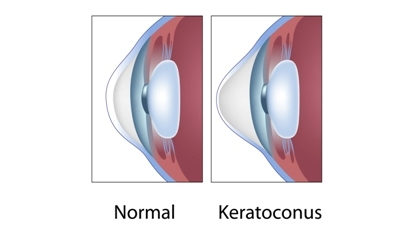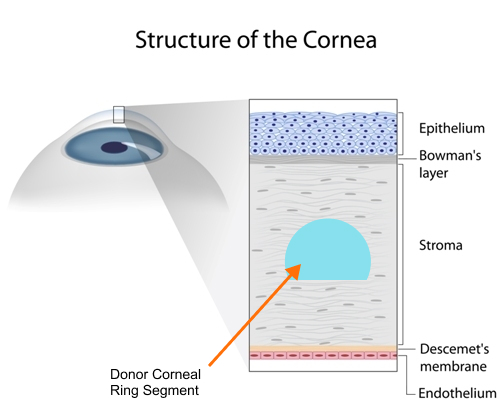What is Keratoconus
Keratoconus affects the clear front window of the eye called the cornea. The Cornea becomes thinner and weaker over time resulting in distortion/bulging of the cornea outwards into a cone shape causing visual distortion and astigmatism. Keratoconus is typically in both eyes and can be associated with hay fever, allergic conjunctivitis and eye rubbing. Affected patients will typically worsen in their teens and twenties, and stabilize in their thirties. During this high-risk period patients need regular eye checks including corneal scans to monitor for worsening.
What is CAIRS?
Corneal Allogenic Intrastromal Ring Segments (CAIRS) is the next generation of intracorneal ring segments used to reverse the effects of keratoconus by flattening the central cornea. The 30 minute procedure is performed in two stages.
What is involved?
The first stage is the creation of a laser cut channel in your cornea. This procedure is quick and painless. The second stage involves inserting a segment of a thin ring of donor corneal tissue into the channel.
The placement of the channels and amount of donor corneal tissue used is customized according to the scans of your cornea. After the CAIRS procedure, you may require corneal cross linking (CXL) to strengthen the cornea and/or more laser to further improve the quality of vision.
Benefits of CAIRS
CAIRS is a minimally invasive surgical option to improve patients vision without converting to a full corneal transplant. The potential complications and risk profile of CAIRS is dramatically better than a full corneal transplant, which is often patients only other option. CAIRS is reversible. A CAIRS segment cannot be rejected and therefore does not require long-term management.
Risks
CAIRS is safe and the risks are minimal, but there is a small chance of infection, scarring, corneal haze and reduction in vision. Your Doctor will go into more detail about these risks during your consult. After treatment you will still need to wear spectacles or contact lenses.
CAIRS is a new treatment and long term follow up data is not currently available. Although the likelihood of patients’ results being permanent is high.
Normal Experiences after the procedure
Recovery is quick with minimal pain or discomfort, however it is recommended that you take up to a week off from work afterwards. Vision improves quickly but depends on your severity of keratoconus. At 3 months your vision and cornea will have stabilised and the second stage of your treatment will be further laser/crosslinking, glasses or contact lenses. Post-operative drops are required to aid in healing and instructions will be provided to you.



